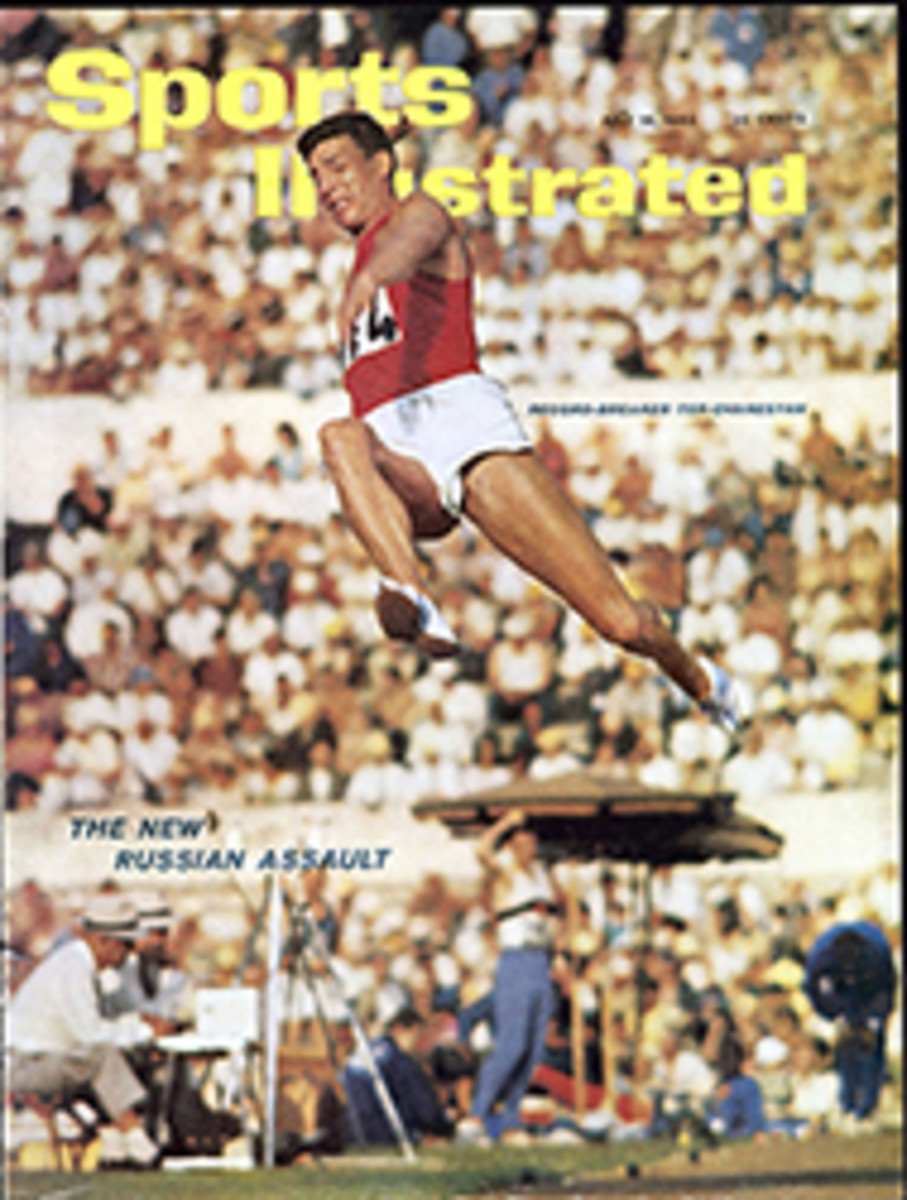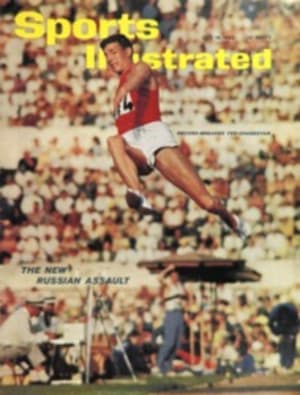
U.S. AND U.S.S.R. ABOUT-FACE
In the National AAU championships in Walnut. Calif., four Americans, for the first time, finished a mile race in well under four minutes (pleasing President Kennedy and track fans everywhere). A week later, in Chicago, a Polish sprinter beat the best the U.S. had to offer at 200 meters.
This represents a trend in world track and field competition. The United States is developing rapidly in the events in which Americans have never before achieved world class, but the Europeans, especially the Russians, are rapidly closing the gap on American athletes in events in which we traditionally have excelled. Luckily for the U.S., we seem thus far to be making longer—and faster—strides than the foreigners.
What this means in our most immediate test of strength is this: in the dual meet At Palo Alto against the Russians next week the U.S. is likely to win most of the events it is used to winning, but by dwindling margins; we will also win some events in which the Russians have heretofore owned a clear superiority. Since the Russians are competing on foreign soil after a long trip, the American men's margin of overall victory may be deceptively large; we certainly will win the men's competition easily and we can, for the first time, win in combined scoring of men's and women's events. If this happens we may, also for the first time, recognize the combined score as official.
Certainly, the Russians must be considered better in the high jump. Valerl Brumel, a 20-year-old undergraduate at Moscow's Stalin Institute of Physical Culture, holds the world record; more important, he holds a clear-cut psychological edge over the U.S.'s John Thomas. He has never failed to beat Thomas. It is unlikely that he will fail this time, and this year the No. 2 Russian, Victor Bolshov, has jumped higher than either Thomas or Gene Johnson. In the broad jump, crew-cut, English-speaking Igor Ter-Ovanesyan (see cover), who likes American jazz, recently broke the world record with a jump some nine inches longer than the best Ralph Boston has achieved this year. But Boston holds a psychological edge over Ter-Ovanesyan, as Brumel does over Thomas.
For the first time in Russian-American dual meets the Russian team should finish one-two in the decathlon. Rafer Johnson has retired and Phil Mulkey, Johnson's likely successor, did not qualify. This leaves the field open for two Russians: Vasili Kuznetsov, who has scored 8,357 points in this event, and Yuri Kutenko, who must be rated much better than either U.S. entry. The decathlon, of course, fits the Russian temperament neatly; it is an event in which meticulous attention to detail is often more rewarding than élan or explosive energy.
This Russian attention to the fine points of athletics has paid off, too, for the Russian sprinters. Russian authorities believe that their sprinters are as good as any in the world. This is not so. But Russian attention to the mechanics of starting has developed new, young dash men who get off the blocks almost as fast as Germany's Armin Hary; so, however, do America's Roger Savers, Bob Hayes and Paul Drayton. And, in spite of Russian claims to the contrary, all three American sprinters are moving more rapidly than their Russian counterparts in the closing yards of both the 100 and 200 meters. The sprints, because of the improved Russian start, should be closer, but should end, as usual, one-two for the U.S.
From 400 through 1,500 meters, the Soviet team is simply no match for the U.S. Probably never in the history of world track has one nation had so clear an advantage in the quarter mile as the U.S. has today. All of our great 400-meter runners at this distance are young—and superbly fast. Ulis Williams, a 20-year-old, has run 46.0; Ray Saddler, barely 19, has done 46.2. None of the Russians has been—or will be—within a second of these times in the meet in Palo Alto. That, of course, bodes ill for the Russian 1,600-meter relay team, which may finish so far back that the Americans will have put on their sweat suits before the Russians finish.
Although the American sprinters, man for man, are faster than their Russian adversaries, the 400-meter relay could be an upset. The Russian relay team has worked together for months to sharpen the split-second efficiency of their baton-passing; the Americans, against Poland, passed with leisurely attention to avoidance of a foul, giving away almost a full second to make sure they would not be disqualified. With only a brief time to become accustomed to one another, it is unreasonable to expect that they will improve spectacularly in passing. If they do not, the Russians can gain two yards or more per baton pass, possibly enough to prove that the race will go to the better passers, not the better runners.
At 800 meters, Jerry Siebert and Jim Dupree of the U.S. are both faster and smarter than the Russian duo of Abram Krivosheyev and Valeri Bulishev. The Russians are pattern runners in this race, as they are in most of the longer distances. Left alone to set and maintain their own pace, they perform creditably, although not as well as the Americans. In a tactical race—and this is likely to be one—they do not react well when someone else sets a faster early pace than they prefer, or begins a finishing kick before they are ready.
A shoo-in
The same, of course, holds true in the 1,500 meters, a distance at which American runners are rapidly overtaking the rest of the world. With the superlative tactical sense developed in Jim Beatty and Jim Grelle by the canny expatriate, Hungarian Mihaly Igloi, you would have to pick the U.S. entry to finish one-two, even if their times were not appreciably better than the Russians'. When you combine this with their superior basic speed it becomes immediately apparent that this race is a shoo-in for the U.S.
At 5,000 meters, the principal question is how much age has withered the undeniable talents of Russia's 10,000-meter Olympic champion, Pyotr Bolotnikov. He has not run particularly well this season: if he does not bring himself up to at least a reasonable semblance of his 1960 form, indefatigable little Max Truex, improving steadily under Igloi's tutelage, might very well defeat him. Again, this will be a tactical race; Truex failed in tactics against the Poles, allowing himself to be boxed by the No. 2 Polish 5,000-meter runner at the very moment the best Pole bid for an untouchable lead.
At 10,000 meters, the Russians appear too strong, although Peter McArdle, a bald 32-year-old who has just received his American citizenship after five years here from Ireland, gives the U.S. more strength than usual in this event.
Of course, in all the races from 800 to 10,000 meters, including the 3,000-meter steeplechase (in which the U.S.S.R. is easily preeminent), the U.S. runners can look forward to a steaming pace from the outset. The Russians seldom win a race on a fast finish; they prefer to deprive the competition of a kick by wearing them out with a violent early effort.
In the hurdle races, Jerry Tarr and Hayes Jones are the world's best at 110 meters; as the Americans battle for first at the finish, the Russians may well be still clearing the final hurdle. And Rex Cawley and Willie Atterberry, although their margin of victory may be more precarious, are strong enough for a sweep in the 400-meter hurdles, especially since the Russians are used to following a set strategy in this race and cannot respond to a variance in pattern.
The Russian pole vaulters, like most Europeans, have adopted the fiber-glass pole, but they have not converted to it as readily as has Ron Morris, who was the most consistent American vaulter on steel and is the most consistent now on fiber glass. Nor can the Russians match with fiber glass the heights of the last of our steel pole users, John Cramer.
On paper, Russian discus thrower Vladimir Trusenyev, who held the world record at 202 feet 2½ inches until Al Oerter broke it against the Poles, appears almost the equal of Oerter and easily better than Rink Babka, America's No. 2. But Trusenyev has accomplished his best throws in small district meets; Oerter and Babka respond best to the pressure of big meets—they finished one-two in the 1960 Olympics, for example.
As for the rest of the field events, our shotputters are unbeatable, our hop, step and jump competitors are a small step behind the Russians and our javelin throwers are 20 feet short.
The women? We're improving. If Wilma Rudolph returns to form, we could win both sprints and the women's sprint relay. Leah Bennett set an American record in the 800-meter run in Chicago, but the same time would leave her some 40 yards behind the best Russian. Earlene Brown is still redoubtable in the shot and the discus and Olga Connolly is better than Earlene in the latter event, but Russia holds world records in these events, as indeed it does in most women's track and field competition.
We will, of course, win the men's competition. We won't be disgraced in the women's. But even if the men's team score is not close, most of the races very probably will be.
[originallink:10511416:42557]
* time for yards

